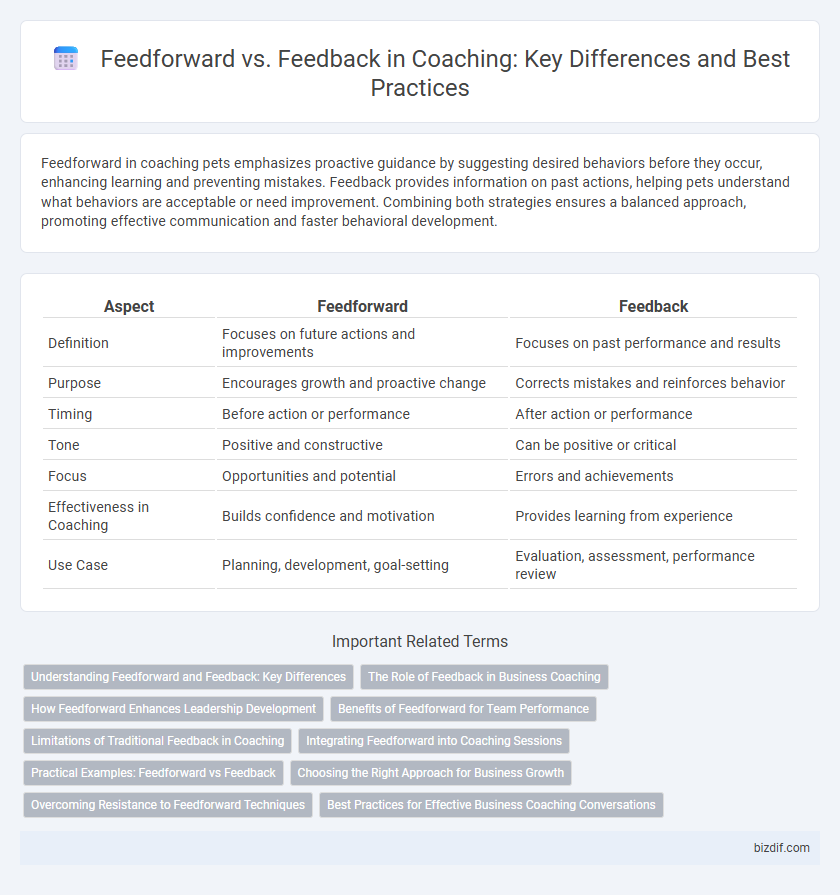Feedforward in coaching pets emphasizes proactive guidance by suggesting desired behaviors before they occur, enhancing learning and preventing mistakes. Feedback provides information on past actions, helping pets understand what behaviors are acceptable or need improvement. Combining both strategies ensures a balanced approach, promoting effective communication and faster behavioral development.
Table of Comparison
| Aspect | Feedforward | Feedback |
|---|---|---|
| Definition | Focuses on future actions and improvements | Focuses on past performance and results |
| Purpose | Encourages growth and proactive change | Corrects mistakes and reinforces behavior |
| Timing | Before action or performance | After action or performance |
| Tone | Positive and constructive | Can be positive or critical |
| Focus | Opportunities and potential | Errors and achievements |
| Effectiveness in Coaching | Builds confidence and motivation | Provides learning from experience |
| Use Case | Planning, development, goal-setting | Evaluation, assessment, performance review |
Understanding Feedforward and Feedback: Key Differences
Feedforward focuses on future-oriented guidance that aims to improve upcoming performance, while feedback centers on assessing past actions to identify areas of improvement. Feedforward promotes positive change by offering constructive suggestions before mistakes occur, whereas feedback analyzes completed tasks to reinforce strengths or correct errors. Understanding the distinction enhances coaching effectiveness by balancing motivational support with reflective learning.
The Role of Feedback in Business Coaching
Feedback in business coaching serves as a critical tool for performance improvement by providing specific, actionable insights into current behavior and outcomes. It helps identify strengths and areas for growth, enabling clients to adjust strategies and enhance skills in real time. Effective feedback fosters a growth mindset, driving continuous learning and increased accountability within leadership development.
How Feedforward Enhances Leadership Development
Feedforward enhances leadership development by focusing on future-oriented suggestions rather than past mistakes, enabling leaders to adapt and grow proactively. This approach promotes a positive mindset, fosters continuous improvement, and encourages innovative problem-solving in leadership practices. Emphasizing actionable insights, feedforward supports goal-setting aligned with evolving organizational objectives, driving sustained performance improvement.
Benefits of Feedforward for Team Performance
Feedforward enhances team performance by focusing on future possibilities and actionable suggestions, which fosters a positive and growth-oriented environment. Unlike feedback that often dwells on past mistakes, feedforward encourages proactive problem-solving and innovation, improving motivation and collaboration within the team. This approach accelerates learning curves and drives continuous improvement, leading to higher productivity and stronger team cohesion.
Limitations of Traditional Feedback in Coaching
Traditional feedback in coaching often emphasizes past performance, which can limit its effectiveness by fostering defensiveness and reducing motivation for change. This retrospective focus may result in fixed mindsets rather than promoting growth, hindering the coachee's ability to envision future improvements. Feedforward, as an alternative, encourages actionable suggestions and forward-looking development, addressing these limitations by fostering a more positive and dynamic coaching experience.
Integrating Feedforward into Coaching Sessions
Integrating feedforward into coaching sessions shifts the focus from past performance evaluation to proactive future-oriented guidance, enhancing client motivation and goal clarity. Effective feedforward emphasizes actionable suggestions that clients can implement immediately, fostering continuous improvement and adaptive learning. This approach complements traditional feedback by promoting a growth mindset and empowering clients to envision and achieve their desired outcomes.
Practical Examples: Feedforward vs Feedback
Feedforward emphasizes future improvement by offering actionable suggestions before performance, such as advising a speaker on enhancing their presentation skills prior to a meeting. Feedback centers on evaluating past actions, like providing constructive critiques after a project has concluded to improve future tasks. Practical application shows feedforward fosters proactive development, whereas feedback promotes reflection and learning from past experiences.
Choosing the Right Approach for Business Growth
Feedforward emphasizes future-focused guidance that drives continuous improvement and goal achievement, making it ideal for fostering innovation and proactive change in business growth. Feedback centers on reviewing past performance to identify strengths and areas for development, providing valuable insights for course correction and skill enhancement. Selecting the appropriate approach depends on whether the business aims to inspire forward momentum with actionable advice or refine existing processes through reflective analysis.
Overcoming Resistance to Feedforward Techniques
Overcoming resistance to feedforward techniques involves shifting the focus from past mistakes to future possibilities, which can reduce defensiveness and encourage openness. Emphasizing actionable suggestions and positive intentions fosters a growth mindset, making individuals more receptive to constructive guidance. Coaches can enhance acceptance by framing feedforward as an opportunity for development rather than criticism, promoting collaboration and motivation.
Best Practices for Effective Business Coaching Conversations
Effective business coaching conversations emphasize feedforward by providing actionable suggestions that focus on future improvements rather than past mistakes, fostering a growth-oriented mindset. Best practices include using clear, specific language that empowers clients to envision and implement positive changes, while maintaining a collaborative and supportive tone. Combining feedforward with selective, constructive feedback enhances clarity and motivation, driving continuous performance development and stronger professional relationships.
Feedforward vs Feedback Infographic

 bizdif.com
bizdif.com